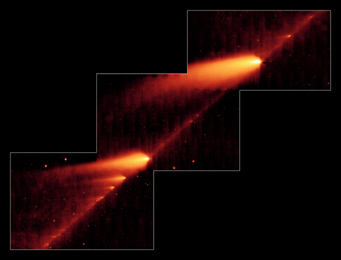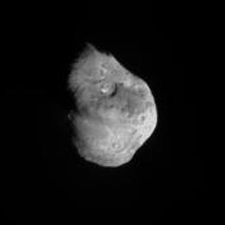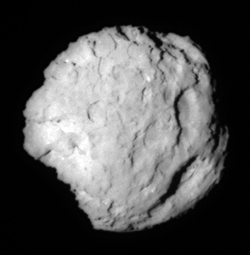
The Spitzer Space Telescope captured this infrared view of crumbling Comet 73P/Schwassman-Wachmann-3 and its multiple fragments. Notice the pronounced dust trail. When Earth passes through the debris field, we see it as the Tau Herculid meteor shower.
NASA/JPL/Caltech/W. Reach (SSC/Caltech)
At this week's Division for Planetary Sciences meeting in Pasadena, California, astronomers spent two days presenting research on the elusive question of comet composition. Experts lump comets into two large bins: short-period, Jupiter-family comets (JFCs) that don't venture too far from the Sun (at present), and Oort Cloud comets arriving from the extreme distance. One might assume that the makeup of dirty snowballs would be consistent within each of these two bins. However, the consensus heard through the halls of the Pasadena Convention Center this week is that JFCs can differ wildly from each other.
Things began with a discussion of the recent drama-filled apparition of Comet 73P/Schwassman-Wachmann 3. Hal Weaver (Johns Hopkins University) reported Hubble Space Telescope observations of this crumbling JFC. He observed more than 60 fragments — and according to Weaver and several other presenters, the pieces all had basically the same composition. Before the comet crumbled, it seems to have had no variation in composition with depth.
Yet no clear answer was given as to why the comet broke apart. There were no tidal forces to rip it to pieces the way Shoemaker-Levy 9 was pulled apart by Jupiter's gravity in 1994. Moreover, Imre Toth (Konkoly Observatory, Hungary) calculated that despite being a rapid rotator, SW3 was "stable against rotational breakup." And SW3 isn't the first JFC to break apart in recent memory — Comet 1999/S4 (LINEAR) similarly dissolved in 2000.
So if it wasn't tides, might breakup-readiness be an internal characteristic of some JFCs? That was the suggestion of Michael Mumma (Goddard Space Flight Center) and others. Disintegration of the nucleus could be a signature of one type of JFC, meaning there could be several classes of objects within that bin.

This image shows comet Tempel 1 six minutes before it ran over NASA's Deep Impact probe. The picture, which reveals craters and other geologic features, was shot by the probe's impactor targeting sensor.
Meanwhile, in a presentation that updated his paper in Science last August, Casey Lisse (University of Maryland) presented Spitzer Space Telescope observations detailing the spectral composition of Comet 9P/Tempel 1, the object that the Deep Impact probe imaged and slammed into on July 4, 2005. The spectral signature of the collisional debris cloud closely matched the infrared signature of Comet C/1995 O1 (Hale-Bopp) as seen from Earth. It was also similar to what's seen in the young circumstellar disk around the star HD 100546. "For simple systems, stars that are first formed, very simple things, I think we may have a Rosetta stone of what these things are made of."
However, as reported in August, Lisse's Rosetta Stone radically differs from "ground truth," namely the JFC samples brought back to Earth from the Stardust spacecraft in January. Despite both being JFCs, Deep Impact's Tempel 1 and Stardust's Comet 81P/Wild 2 couldn't be more different. As the images at right show, they have drastically different morphology — Wild 2 shows a young surface with numerous sinkholes, while Tempel 1 appears to be a more aged body with impact craters and evidence of surface geological processes.

In January 2006, the Stardust mission returned dust grains from Comet Wild 2. Seen here in 2004, the comet's surface is young, and is covered with sink holes and depressions.
Selby Cull
Moreover, they have drastically different chemical compositions. With the exception of the magnesium-olivine mineral forsterite (Mg2SiO4), the two comets share only a scant few minerals. "There are huge differences between these two missions," says Stardust Principal Investigator Don Brownlee (University of Washington).
Again, it seems that JFCs don't fit in one bin. Why not? Maybe JFCs just come in different flavors. But comet scientist Paul Weissman (Jet Propulsion Laboratory) thinks the answer could be evolution. Perhaps the chemical makeup of fresher and more eroded comets is quite different. Or perhaps it goes back to a question of origin — maybe different JFCs formed at different times and places in the young solar system, and thus are made of different minerals. As such, some might be more apt to fall apart than others.
For now the best suggestion comes from the lead scientist of the Pluto-bound New Horizons mission, S. Alan Stern (Southwest Research Institute, Colorado). There are billions of comets in the solar system, he says. "Be careful not to generalize things."
 0
0
Comments
You must be logged in to post a comment.